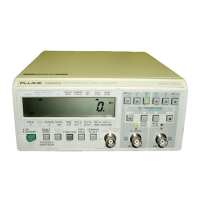
Do you have a question about the Fluke PM 6666 and is the answer not in the manual?
Read this page carefully before you install and use the PM 6666 Timer/Counter.
Use generally-accepted safety procedures and heed specific warning statements in the manual.
Explains symbols used in the manual related to safety.
Procedure to follow when suspecting unsafe operation.
Description of the PM 6666 Timer/Counter, its features, and available options.
Description of the connectors and controls on the rear panel of the instrument.
Description of the front panel controls and indicators of the Timer/Counter.
Steps for unpacking the Timer/Counter and checking contents.
How to set the correct voltage range for the instrument before connecting to mains.
Importance and procedure for grounding the Timer/Counter for safety.
How to connect an external 10 MHz reference frequency source.
Information on how to install additional options in the Timer/Counter.
Procedure for recalibrating the MTCXO time-base.
Step-by-step guide for calibrating the MTCXO.
Basic operation of the Timer/Counter, including power and function selection.
Details various measurement functions and their operating ranges.
How to move the function cursor to select different measurement modes.
Explains frequency, period, ratio, and totalize functions and their ranges.
Details on measuring maximum and minimum voltages.
How to select and set the measuring time for operations.
Additional information on voltage and time interval measurements.
Notes on frequency, period, and time measurements for different settings.
Using the RESET/LOCAL and DISPL HOLD buttons for counter control.
How to connect signals to Input-A and Input-B.
Explains the behavior of RESET and LOCAL buttons.
Specifications and connection advice for Input-A and Input-B.
How to use the attenuator and slope selection buttons for inputs.
Configuring AC/DC coupling, auto level, and sensitivity.
How attenuator and sensitivity settings affect measurements.
Using AC/DC coupling and sensitivity for various measurements.
Using READ LEVEL and COM B via A buttons.
How to connect signals to the optional Input-C.
Connecting an external 10 MHz reference.
How trigger levels are displayed and the auto-level function.
How Input-A settings affect Input-B when using COM B via A.
Detailed specifications for the optional HF-input (Input C).
Guidelines for using the external reference input for stability.
Information about the battery unit, operation, charging, and care.
Lists and explains error codes displayed by the counter.
Overview of controlling the PM 6666 via the GPIB interface.
Explains what can be done using the GPIB bus and lists interface functions.
Instructions on how to connect the computer controller to the counter's GPIB interface.
How to set a unique address for the counter for communication.
Procedure to verify communication between the controller and the counter.
Describes manual setup and programmatic message methods for control.
Steps to ensure correct programming and defines command structure.
How to set the message terminator and EOI function.
Using commands to select measurement functions via GPIB.
Setting the measurement duration via GPIB commands.
Configuring input parameters like coupling, attenuation, and sensitivity.
Controlling totalizing functions remotely via GPIB commands.
Explains and configures the counter's measurement modes.
Setting time limits and configuring service requests.
Monitoring counter events and conditions using the status byte.
Procedures for resetting status messages and error conditions.
Selecting the format for measurement results output via GPIB.
Details on normal and short output formats for measurement results.
Enabling fast data transfer for high-rate measurements.
Explains the format of data transferred during high-speed dump.
Formulas to convert register contents to readable results for high-speed dump.
Using queries to retrieve the counter's current configuration.
How switching between local and remote control affects settings.
A comprehensive list of GPIB commands for functions and settings.
Practical examples of controlling the counter with an HP-85 controller.
Example of controlling the counter using an IBM PC with GPIB.
How to query the counter for its current setup parameters.
Example of sending user-defined programming sequences via GPIB.
Detailed specifications for Frequency, Period, Ratio, and Time Interval measurements.
Specifies the frequency ranges for inputs A and B.
Details on the range, frequency, and modes for Totalize A function.
Specifications for measuring maximum and minimum voltages on input A.
Comprehensive specifications for inputs A and B, including sensitivity and trigger.
Specifications for the optional HF-input (Input C).
Specifications for the external reference input.
Information on power, default settings, and RESET/LOCAL functions.
Explains terms like LSD and Resolution used in specifications.
Details on measurement inaccuracies related to resolution, trigger error, and time base.
Specifications for the time bases and the instrument's display.
Operating and storage conditions, dimensions, and weight.
List and description of available accessories like GPIB interface and carrying case.
Details on high-speed dump functionality and output data formats.
Specifications for PM 9606/01 and PM 9606/02 rack mounting adapters.
Model numbers, options, and included items for ordering.
Explains counter sensitivity and factors affecting it.
Test setup and procedure for checking sensitivity with high impedance inputs.
Test setup and procedure for checking sensitivity with low impedance inputs.
